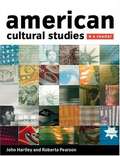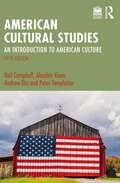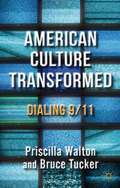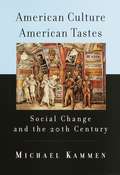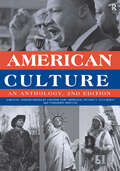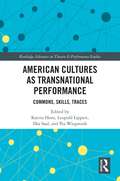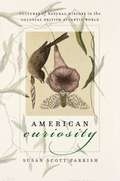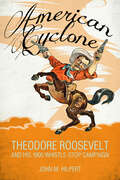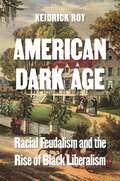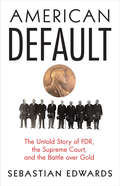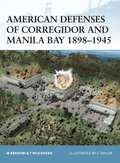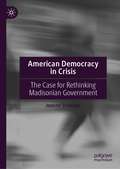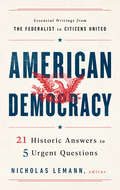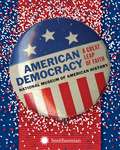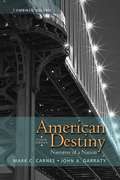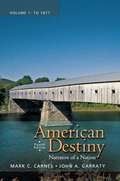- Table View
- List View
American Cultural Studies: A Reader
by John Hartley Roberta E. Pearson Eva ViethThis provocative new collection shows how the burgeoning field of cultural studies has developed in the U. S. Introducing vital concepts, arguments, theories, and disciplinary debates, American Cultural Studies: A Reader is a panorama of great writing and powerful ideas. It illustrates a uniquely American response to questions of power and identity in the politics of culture. More than forty selections from key figures in "new journalism," cultural theory, the social sciences, humanities, and visual arts are gathered together in seven sections, each one introduced by helpful notes. A general introductory chapter explains the editorial selection and offers a new account of cultural studies and American studies in relation to American culture. The Epilogue suggests new ways--via the Internet--of doing cultural studies and of thinking about America.
American Cultural Studies: An Introduction to American Culture
by Neil Campbell Alasdair KeanExploring the central themes in modern American cultural studies and discussing how these themes can be interpreted, American Cultural Studies offers a wide-ranging overview of different aspects of American cultural life such as religion, gender and sexuality, regionalism, and ethnicity and immigration. The fourth edition has been revised throughout to take into account the developments of the last four years. Updates and revisions include: discussion of Barack Obama's time in the White House consideration of 'Hemispheric American Studies' and the increasing debates about globalisation and the international role of the USA long-form television and American Studies up-to-date case studies, such as Girls, The Wire and Orange is the New Black more material on Detroit, the Mexican border, same-sex relationships and Islam in America updated further reading lists and new follow-up work. Illustrated throughout, containing follow-up questions and further reading at the end of each chapter, and accompanied by a companion website (www.routledge.com/cw/campbell) providing further study resources, American Cultural Studies is a core text and an accessible guide to the interdisciplinary study of American culture.
American Cultural Studies: An Introduction to American Culture
by Neil Campbell Alasdair Kean Andrew Dix Peter TempletonNow in its fifth edition, American Cultural Studies continues to offer a critical introduction to key concepts, topics and methods in the study of United States culture, exploring subjects that include the city, ethnicity and immigration, religion, youth, and gender and sexuality.The fifth edition has been comprehensively revised to take account of developments in American culture during the past decade. Arguments are supported by close readings of cultural materials that range from novels to paintings, films to political speeches and TV shows to regional cuisines. Updated case studies introduce each chapter, with examples including Moonlight, The Great Gatsby and the songs and videos of Lady Gaga. This book also offers a new chapter on class; extended discussion of gender and sexuality, including masculinities and trans culture; and increased coverage of sports in American culture, including baseball, wrestling and American football. To further engage contemporary readers, this edition provides up-to-date further reading suggestions for each chapter and considers the place of American cultural studies in the current moment.Of particular interest to undergraduate readers, this book is panoramic in its coverage of the field and is a core text for studying American culture.Instructor and student resources for this book include an interactive timeline of cultural and historical events, additional discussion questions and activities for each topic, and suggestions for further reading and online resources for each chapter.
American Culture Transformed
by Priscilla L. Walton Bruce TuckerThe bombing of the Twin Towers in New York on September 11, 2001, marked a major turning point in modern American culture. Authors Bruce Tucker and Priscilla L. Walton examine critical moments in the aftermath of 9/11 arguing that commentators abandoned complexity, seeking to reduce events to their simplest signification.
American Culture, American Tastes: Social Change and the 20th Century
by Michael KammenAmericans have a long history of public arguments about taste, the uses of leisure, and what is culturally appropriate in a democracy that has a strong work ethic. Michael Kammen surveys these debates as well as our changing taste preferences, especially in the past century, and the shifting perceptions that have accompanied them.Professor Kammen shows how the post-traditional popular culture that flourished after the 1880s became full-blown mass culture after World War II, in an era of unprecedented affluence and travel. He charts the influence of advertising and opinion polling; the development of standardized products, shopping centers, and mass-marketing; the separation of youth and adult culture; the gradual repudiation of the genteel tradition; and the commercialization of organized entertainment. He stresses the significance of television in the shaping of mass culture, and of consumerism in its reconfiguration over the past two decades.Focusing on our own time, Kammen discusses the use of the fluid nature of cultural taste to enlarge audiences and increase revenues, and reveals how the public role of intellectuals and cultural critics has declined as the power of corporate sponsors and promoters has risen. As a result of this diminution of cultural authority, he says, definitive pronouncements have been replaced by divergent points of view, and there is, as well, a tendency to blur fact and fiction, reality and illusion.An important commentary on the often conflicting ways Americans have understood, defined, and talked about their changing culture in the twentieth century.
American Culture: An Anthology
by Anders Breidlid Fredrik Chr. Brøgger Oyvind T. Gulliksen Torbjorn SirevagThis second edition of American Culture includes contemporary events and provides an introduction to American civilization. Extracts are taken from diverse sources such as political addresses, articles, interviews, oral histories and advertisements. Edited by academics who are highly experienced in the study and teaching of American Studies across a wide range of institutions, this book provides: texts that introduce aspects of American society in a historical perspective primary sources and images that can be used as the basis for illustration, analysis and discussion linking text which stresses themes rather than offering a simple chronological survey. American Culture brings together primary texts from 1600 to the present day to present a comprehensive overview of, and introduction to, American culture.
American Cultures as Transnational Performance: Commons, Skills, Traces (Routledge Advances in Theatre & Performance Studies)
by Katrin Horn Ilka Saal Pia Wiegmink Leopold LippertThis book investigates transnational processes through the analytic lens of cultural performance. Structured around key concepts of performance studies––commons, skills, and traces––this edited collection addresses the political, normative, and historical implications of cultural performances beyond the limits of the (US) nation-state. These three central aspects of performance function as entryways to inquiries into transnational processes and allow the authors to shift the discussion away from text-centered approaches to intercultural encounters and to bring into focus the dynamic field that opens up between producer, art work, context, setting, and audience in the moment of performance as well as in its afterlife. The chapters provide fresh, performance-based approaches to notions of transcultural mobility and circulation, transnational cultural experience and knowledge formation, transnational public spheres, and identities’ rootedness in both specific local places and diasporic worlds beyond the written word. This book will be of great interest to scholars and students of American studies, performance studies, and transnational studies
American Curiosity
by Susan Scott ParrishColonial America presented a new world of natural curiosities for settlers as well as the London-based scientific community. In American Curiosity, Susan Scott Parrish examines how various peoples in the British colonies understood and represented the natural world around them from the late sixteenth century through the eighteenth. Parrish shows how scientific knowledge about America, rather than flowing strictly from metropole to colony, emerged from a horizontal exchange of information across the Atlantic.Delving into an understudied archive of letters, Parrish uncovers early descriptions of American natural phenomena as well as clues to how people in the colonies construed their own identities through the natural world. Although hierarchies of gender, class, institutional learning, place of birth or residence, and race persisted within the natural history community, the contributions of any participant were considered valuable as long as they supplied novel data or specimens from the American side of the Atlantic. Thus Anglo-American nonelites, women, Indians, and enslaved Africans all played crucial roles in gathering and relaying new information to Europe. Recognizing a significant tradition of nature writing and representation in North America well before the Transcendentalists, American Curiosity also enlarges our notions of the scientific Enlightenment by looking beyond European centers to find a socially inclusive American base to a true transatlantic expansion of knowledge.
American Cyclone: Theodore Roosevelt and His 1900 Whistle-Stop Campaign
by John M. HilpertWhen Theodore Roosevelt entered national politics as the Republicans' nominee for the vice presidency in 1900, he was only forty-one years old. However, he had caught the public's attention with the popular version of his life story. Child of East Coast privilege. Sickly, bespectacled youth. Naturalist and author. Harvard graduate. New York assemblyman. Young widower. Badlands cowboy. Civil Service reformer. Urban police commissioner. Assistant Secretary of the Navy. Rough Rider and war hero. Enemy of political bosses as governor of the nation's most important state. Attentive husband to his second wife, Edith, and the father of six children. Few candidates for the presidency or vice presidency have enjoyed the elevated level of admiration accorded Roosevelt in the waning days of the nineteenth century. Biographers have chronicled every significant period of Roosevelt's life with one exception, and American Cyclone fills that gap. His nomination for the vice presidency was Roosevelt's debut as a candidate for national office. American Cyclone presents the story of his campaign, a whirlwind effort highlighted by an astounding whistle-stop tour of 480 communities across twenty-three states. Eighteen of those states gave a plurality of votes to the McKinley-Roosevelt ticket, a gain of five states for the Republicans over 1896. Everywhere Roosevelt went, admiring throngs and dramatic events helped forge him into the man who would soon be the twenty-sixth president of the United States. Returning from the war, Roosevelt was familiar to millions of people across the country as a determined leader. As he interacted with crowds of hundreds, thousands, and even tens of thousands, Roosevelt felt their eagerness to see and hear him. Accordingly, for the first time, this whistle-stop campaign marks the development of the confidence and maturity that would transform Roosevelt into a national leader.
American Dark Age: Racial Feudalism and the Rise of Black Liberalism
by Keidrick RoyHow medieval-inspired racial feudalism reigned in early America and was challenged by Black liberal thinkersThough the United States has been heralded as a beacon of democracy, many nineteenth-century Americans viewed their nation through the prism of the Old World. What they saw was a racially stratified country that reflected not the ideals of a modern republic but rather the remnants of feudalism. American Dark Age reveals how defenders of racial hierarchy embraced America&’s resemblance to medieval Europe and tells the stories of the abolitionists who exposed it as a glaring blemish on the national conscience.Against those seeking to maintain what Frederick Douglass called an &“aristocracy of the skin,&” Keidrick Roy shows how a group of Black thinkers, including Frances Ellen Watkins Harper, Hosea Easton, and Harriet Jacobs, challenged the medievalism in their midst—and transformed the nation&’s founding liberal tradition. He demonstrates how they drew on spiritual insight, Enlightenment thought, and a homegrown political philosophy that gave expression to their experiences at the bottom of the American social order. Roy sheds new light on how Black abolitionist writers and activists worked to eradicate the pernicious ideology of racial feudalism from American liberalism and renew the country&’s commitment to values such as individual liberty, social progress, and egalitarianism.American Dark Age reveals how the antebellum Black liberal tradition holds vital lessons for us today as hate groups continue to align themselves with fantasies of a medieval past and openly call for a return of all-powerful monarchs, aristocrats, and nobles who rule by virtue of their race.
American Daughter
by Elizabeth KendallIn this beautifully crafted book, Elizabeth Kendall tells the story of a family, of a passionate attachment between a mother and a daughter and the sudden tragedy that tears it apart. American Daughter is also a brilliant portrait of wellborn women's lives in cities and towns in the post-World War II era, as Kendall evokes how difficult it was to become anything other than an American daughter, which meant being a dependent woman. Occupying a coveted place in St. Louis's privileged high society, Henry and Betty Kendall seemed to be the American dream come true: six children, a sprawling house, a legacy of higher education at Harvard and Vassar. Yet underneath lay the flawed marriage of an idealistic young woman who made her eldest daughter her best friend and turned civil rights into her salvation. Elizabeth maintained the family silence as eccentricities began to appear in her father's behavior, along with whispers of financial difficulties. She accompanied her mother back to Vassar for a summer program on the home and family, then came into her own, away from her family, at the haven of a girls' summer camp and at Radcliffe. From the war-torn 1940s, when young men in uniform, home on leave, went to debutante parties, through the seismic social changes of the 1960s, Kendall tells the intertwined story of her mother and herself, of their powerful bond and how both shaped their lives in response to it. Unrelentingly honest, rich with humor and insights into families and women's lives, American Daughter is both a poignant portrait of American life at the middle of the twentieth century, and a dual coming-of-age story of a mother and a daughter, united by commitment and love, separated by a fatal accident-and by the vastly different birthrights of their generations.From the Hardcover edition.
American Daughter Gone to War: On the Front Lines with an Army Nurse in Vietnam
by Winnie SmithA former member of the Army Nurse Corps in Vietnam recalls her tour of duty and her difficult adjustment to civilian life.
American Daughters: A Novel
by Piper HuguleyIn the vein of America’s First Daughter, Piper Huguley’s historical novel delves into the remarkable friendship of Portia Washington and Alice Roosevelt, the daughters of educator Booker T. Washington and President Teddy Roosevelt.At the turn of the twentieth century, in a time of great change, two women—separated by societal status and culture but bound by their expected roles as the daughters of famed statesmen—forged a lifelong friendship. Portia Washington’s father Booker T. Washington was formerly enslaved and spent his life championing the empowerment of Black Americans through his school, known popularly as Tuskegee Institute, as well as his political connections. Dedicated to her father’s values, Portia contributed by teaching and performing spirituals and classical music. But a marriage to a controlling and jealous husband made fulfilling her dreams much more difficult. When Theodore Roosevelt assumed the presidency, his eldest daughter Alice Roosevelt joined him in the White House. To try to win her father’s approval, she eagerly jumped in to help him succeed, but Alice’s political savvy and nonconformist behavior alienated as well as intrigued his opponents and allies. When she married a congressman, she carved out her own agendas and continued espousing women’s rights and progressive causes. Brought together in the wake of their fathers’ friendship, these bright and fascinating women helped each other struggle through marriages, pregnancies, and political upheaval, supporting each other throughout their lives. A provocative historical novel and revealing portrait, Piper Huguley’s American Daughters vividly brings to life two passionate and vital women who nurtured a friendship that transcended politics and race over a century ago.
American Deadline: Reporting from Four News-Starved Towns in the Trump Era (Columbia Journalism Review Books)
by Charles Richardson Greg Glassner Sandra Sanchez Jason TogyerThe dramatic events of 2020—the presidential election, the COVID-19 pandemic, protests for racial justice—affected every corner of American life. What did these events mean for the residents of small towns and cities that are often overlooked by national newspapers? How do local stories change when they are told by journalists with roots in these communities? And what is lost as this kind of coverage disappears?American Deadline brings together dispatches from four longtime local journalists in different parts of the United States that tell the story of 2020 anew. It shares reporting from Bowling Green, Virginia; Macon, Georgia; McKeesport, Pennsylvania; and McAllen, Texas—two towns that lost their local newspapers and two where they are barely hanging on. The authors consider what makes each town distinctive and how these local perspectives tell a part of a broader American story. This book reports on how residents of these towns grapple with and talk about issues relating to race, schooling, health, immigration, deindustrialization, as well as local and national politics amid a changing and increasingly precarious information ecosystem. A distinct and intimate look at a calamitous year, American Deadline is an important book for all readers interested in the possibilities and future of local journalism.
American Default: The Untold Story of FDR, the Supreme Court, and the Battle over Gold
by Sebastian EdwardsThe untold story of how FDR did the unthinkable to save the American economyThe American economy is strong in large part because nobody believes that America would ever default on its debt. Yet in 1933, Franklin D. Roosevelt did just that, when in a bid to pull the country out of depression, he depreciated the U.S. dollar in relation to gold, effectively annulling all debt contracts. American Default is the story of this forgotten chapter in America's history.Sebastian Edwards provides a compelling account of the economic and legal drama that embroiled a nation already reeling from global financial collapse. It began on April 5, 1933, when FDR ordered Americans to sell all their gold holdings to the government. This was followed by the abandonment of the gold standard, the unilateral and retroactive rewriting of contracts, and the devaluation of the dollar. Anyone who held public and private debt suddenly saw its value reduced by nearly half, and debtors--including the U.S. government—suddenly owed their creditors far less. Revaluing the dollar imposed a hefty loss on investors and savers, many of them middle-class American families. The banks fought back, and a bitter battle for gold ensued. In early 1935, the case went to the Supreme Court. Edwards describes FDR's rancorous clashes with conservative Chief Justice Charles Evans Hughes, a confrontation that threatened to finish the New Deal for good—and that led to FDR's attempt to pack the court in 1937.At a time when several major economies never approached the brink of default or devaluing or recalling currencies, American Default is a timely account of a little-known yet drastic experiment with these policies, the inevitable backlash, and the ultimate result.
American Defenses of Corregidor and Manila Bay 1898-1945
by Chris Taylor Mark BerhowThe Philippines were declared an American Territory on January 4, 1899, and fortification construction soon began on the islands in the mouth of Manila Bay. Among the sites built were Fort Mills (Corregidor), Fort Frank, and the formidable "concrete battleship" of Fort Drum. The defenses suffered constant Japanese bombardment during World War II, leading to the surrender of American forces. In 1945 the forts were manned by Japanese soldiers determined to hold out to the bitter end. This title details the fortifications of this key strategic location, and considers both their effectiveness and historical importance.
American Demagogue: The Great Awakening And The Rise And Fall Of Populism
by J. D DickeyIn September 1740, New England experienced a social earthquake. It arrived not in the form of a great natural disaster or an act of violence, but with the figure of a twenty-year-old preacher. People were abuzz with his stunning oratory, his colorful theatrics, and his almost ungodly sense of power and presence.When George Whitfield arrived in the American colonies, his reputation and growing legend had been built on his brilliant speeches and frightening tirades, and his fame exploded. He demanded his listeners repent their sins and follow the true word of God—his. He had knowledge that only he could unlock for the American people. Whitefield's message also carried a threat, and he brooked no dissent. Whitefield's power over his listeners grew, and New England was in the uproar of a social revolution. This period became known as The Great Awakening, and it would weave its way into the very fabric of what American would eventually become. Soon after Whitefield reached his zenith, things began to fall apart. The puritanical utopia that once seemed so certain vanished like a dream. American Demagogue is the story of this rapid rise and equally steep fall, which would be echoed by authoritarian populists in later centuries and American demagogues yet to come.
American Democracy Now (3rd Edition)
by Brigid Callahan Harrison Jean Wahl Harris Michelle D. DeardorffAmerican Democracy Now, compiled to aid students through the learning process for the American Government. its uniquely collated to achieve better performance on the students, with specific objectives, as it engages the them in the course as well as become better citizens
American Democracy Now (Third Edition)
by Jean Harris Brigid Harrison Michelle DeardorffIncrease student performance, student engagement, and critical analysis skills with the third edition of American Democracy Now. This program is available with GinA, an educational game in which students learn American Government by doing, as well as McGraw-Hill's LearnSmart, an adaptive questioning tool proven to increase content comprehension and improve student results. Unique to this program, American Democracy Now 3e is a student-centered text focused on student performance. This contemporary approach and design, coupled with market-leading digital products, make this an ideal solution to course goals.
American Democracy in Crisis: The Case for Rethinking Madisonian Government
by Jeanne SheehanPublic disenchantment with and distrust of American government is at an all-time high and who can blame them? In the face of widespread challenges—everything from record levels of personal and national debt and the sky high cost of education, to gun violence, racial discrimination, an immigration crisis, overpriced pharmaceuticals, and much more—the government seems paralyzed and unable to act, the most recent example being Covid-19. It’s the deadliest pandemic in over a century. In addition to an unimaginable sick and death toll, it has left more than thirty million Americans unemployed. Despite this, Washington let the first round of supplemental unemployment benefits run out and for more than a month were unable to agree on a bill to help those suffering. This book explains why we are in this situation, why the government is unable to respond to key challenges, and what we can do to right the ship. It requires that readers “upstream,” stop blaming the individuals in office and instead look at the root cause of the problem. The real culprit is the system; it was designed to protect liberty and structured accordingly. As a result, however, it has left us with a government that is not responsive, largely unaccountable, and often ineffective. This is not an accident; it is by design. Changing the way our government operates requires rethinking its primary goal(s) and then restructuring to meet them. To this end, this book offers specific reform proposals to restructure the government and in the process make it more accountable, effective, and responsive.
American Democracy in Crisis: The Case for Rethinking Madisonian Government Post January 6
by Jeanne SheehanThis book analyzes the roots of widespread disenchantment with American government. While blame often falls on the individuals in office, they are not operating in isolation. Rather they are working within a system designed by the Framers with one goal in mind, protectionism. Although the Framers got much right, their commitment to protection of liberty led them to design a system replete with divisions of power. Whatever its merits at the founding, the government today is frequently described as dysfunctional and far too often unresponsive to the majority, unaccountable, and unable to deliver for its people. For those disillusioned with the current state of government and committed to effectuating meaningful change, this book advocates in favor of a fundamental reassessment of the system's primary objectives, followed by deliberation as to how it should be restructured accordingly. It not only presents specific reform proposals, but it ends with a stark warning: until and unless we embrace reasoned structural reform, we cannot be surprised if at some point the people become so frustrated that they either disengage, fight back, or seek solace in autocratic alternatives. This new edition includes audiobook files created by a state of the art text-to-speech tool at the chapter level.
American Democracy: 21 Historic Answers to 5 Urgent Questions
From The Federalist to Citizens United, bestselling author Nicholas Lemann presents key writings on five crucial questions confronting American democracy todayAmid the frenzied overload of 24-hour cable news and incessant social media, at a time when many of us fear for the future of our democracy, it is becoming harder and harder to think clearly about politics. American Democracy: 21 Historic Answers to 5 Urgent Questions provides an alternative for those who want to step back and look to the past for inspiration and guidance. Edited with perceptive and provocative commentary by bestselling historian and journalist Nicholas Lemann (The Promised Land, Transaction Man), the book presents key writings from the American past that speak to five contemporary flashpoints in our political landscape: race, gender, immigration, and citizenship; opportunity and inequality; the purpose and powers of the federal government; money, special privilege, and corruption; and protest and civil disobedience. Some of the selections are well-known--George Washington's letter to the Hebrew Congregation at Newport, Frederick Douglass's "What to the Slave is the 4th of July," Martin Luther King Jr.'s letter from Birmingham Jail--while others will be new to many readers--Horace Mann argument for public schools as a means of fighting inequality, Jane Addams's perceptive analysis of gender and social class in charity work, Randolph Bourne envisioning a "Trans-National America." American Democracy presents a remarkable range of insightful and eloquent American political writing, while serving as an invaluable resource for concerned citizens who wish to become better-informed participants in the ongoing drama of our democracy.
American Democracy: A Great Leap of Faith
by Lisa Kathleen Graddy Barbara Clark Smith Harry R. Rubenstein National Museum of American History William BirdAmerican Democracy: A Great Leap of Faith is the companion volume to an exhibition at the Smithsonian National Museum of American History that celebrates the bold and radical experiment to test a wholly new form of government. Democracy is still a work in progress, but it is at the core of our nation's political, economic, and social life. This lavishly illustrated book explores democracy from the Revolution to the present using objects from the museum's collection, such as the portable writing box that Thomas Jefferson used while composing the Declaration of Independence, the inkstand with which Abraham Lincoln drafted the Emancipation Proclamation, Susan B. Anthony's iconic red shawl, and many more. Not only famous voices are presented: like democracy itself, the book and the exhibition preserve the voice of the people by showcasing campaign materials, protest signs, and a host of other items from everyday life that reflect the promises and challenges of American democracy throughout the nation's history.
American Destiny: Narrative of a Nation (Combined Volume)
by Mark C. Carnes John A. GarratyWith the political history of the nation as its organizational framework, American Destiny: Narrative of a Nation describes the development and growth of the United States as the product of the myriad actions, ideas, and forces of the immense variety of individuals and groups who together comprise the American people.
American Destiny: Narrative of a Nation (Fourth Edition), Volume 1
by Mark C. Carnes John A. GarratyAmerican Destiny's mission is to show readers how history connects to the experiences and expectations that mark their lives. The authors pursue that mission through a variety of distinctive features, including American Lives essays and Re-Viewing the Past movie essays.
